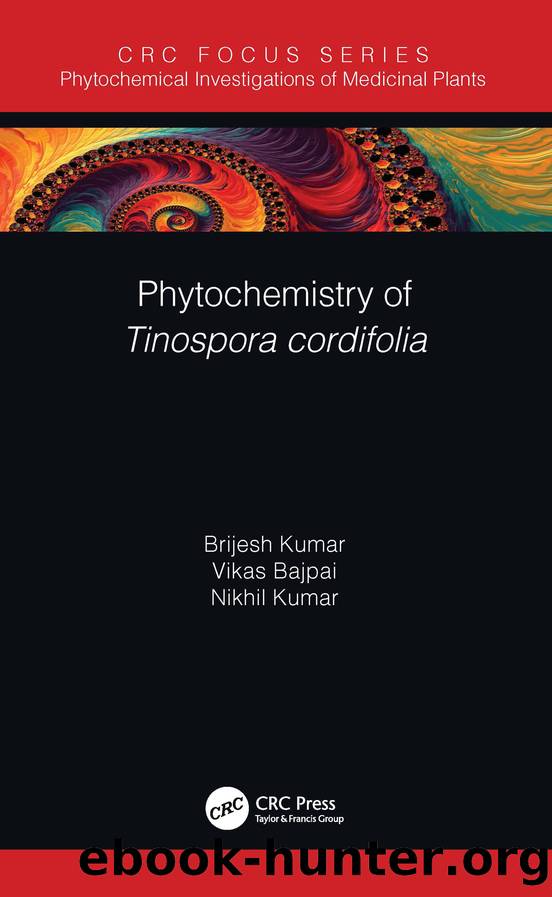Phytochemistry of Tinospora cordifolia by Brijesh Kumar Vikas Bajpai and Nikhil Kumar

Author:Brijesh Kumar, Vikas Bajpai and Nikhil Kumar
Language: eng
Format: epub
Publisher: CRC Press
Published: 2020-07-15T00:00:00+00:00
2.18 Benzylisoquinoline Alkaloids
In TCS, three compounds (at peaks 7, 10 and 12) showed characteristic fragments of benzylisoquinolines. Peak 7 at m/z 272.1271 produced fragment ion at m/z 255.0926 due to loss of methylamine and the most prominent benzylic cleavage fragment ion at m/z 107.0503 and isoquinoline fragment ion at m/z 164.0678. On the basis of the previous reports and recorded MS/MS pattern, peak 7 was identified as the norcoclaurine which is the prototype of the benzylisoquinoline group of alkaloids. Peak 10 was identified as reticuline at m/z 330 (C19H23NO4). Loss of CH3NH2 (m/z 299.1273) followed by CH3OH (m/z 267.1002), the isoquinoline fragment (m/z 192.1019) and the benzylic cleavage fragment (m/z 137.057) supported the identification (Sarma et al., 1998).
The exact mass and molecular formula (m/z 314.1752, C19H24NO3+) of peak 12 corresponded to that of oblongine. Its MS/MS spectrum showed a prominent ion at m/z 58.0663 by RDA fragmentation having a formula [C3H8N]+ due to [(CH3)2N=CH2]+, thereby showing the presence of two methyl groups on the nitrogen. Elimination of (CH3)2NH from [M]+ resulted in the fragment at m/z 269.1176, which further loses CH3OH to yield the fragment at m/z 237.0906. Minor fragment ions at m/z 175.0763, m/z 143.0496, and 145.0620 were supported by available literature (Nair et al., 2006; Peer and Sharma, 1989).
Download
This site does not store any files on its server. We only index and link to content provided by other sites. Please contact the content providers to delete copyright contents if any and email us, we'll remove relevant links or contents immediately.
| Administration & Medicine Economics | Allied Health Professions |
| Basic Sciences | Dentistry |
| History | Medical Informatics |
| Medicine | Nursing |
| Pharmacology | Psychology |
| Research | Veterinary Medicine |
Tuesdays with Morrie by Mitch Albom(4690)
Yoga Anatomy by Kaminoff Leslie(4305)
Science and Development of Muscle Hypertrophy by Brad Schoenfeld(4087)
Bodyweight Strength Training: 12 Weeks to Build Muscle and Burn Fat by Jay Cardiello(3913)
Introduction to Kinesiology by Shirl J. Hoffman(3725)
How Music Works by David Byrne(3186)
Sapiens and Homo Deus by Yuval Noah Harari(2987)
The Plant Paradox by Dr. Steven R. Gundry M.D(2547)
Churchill by Paul Johnson(2506)
Insomniac City by Bill Hayes(2496)
Coroner's Journal by Louis Cataldie(2432)
Hashimoto's Protocol by Izabella Wentz PharmD(2331)
The Chimp Paradox by Peters Dr Steve(2296)
The Universe Inside You by Brian Clegg(2097)
Don't Look Behind You by Lois Duncan(2078)
The Immune System Recovery Plan by Susan Blum(2027)
The Hot Zone by Richard Preston(1983)
Endure by Alex Hutchinson(1964)
Woman: An Intimate Geography by Natalie Angier(1882)
